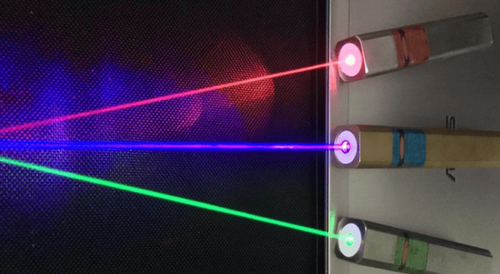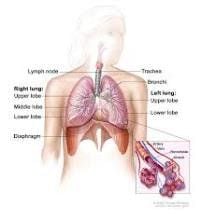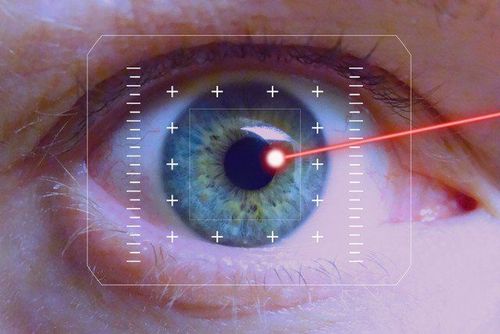This is an automatically translated article.
Laser treatment of tumors and scars of tracheobronchial stenosis is a new high-precision surgical method. The main content of the method is to use laser to burn and remove the tumor / narrow location in the bronchial lumen. Currently, laser treatment of tumors and scars of tracheobronchial stenosis is a type of surgery that leaves the least post-operative complications.
1. An overview of the endoscopic laser treatment of tracheobronchial tumors
a.What is endoscopic laser treatment for tracheobronchitis? Laser is an acronym with the full phrase Light Amplification by Stimulated Emission of Radiation, meaning a type of light amplified by stimulated radiation. In other words, Laser is a type of energy beam that has the property of releasing energy in the form of heat when it hits an object.
Currently, people have been applying lasers in many fields such as welding, cutting, ... structures. The specific effect of a laser often depends on the medium as well as on the wavelength. Based on these superior properties of lasers, modern medicine has begun to apply this type of energy beam in the treatment of many diseases.
For trachea / bronchi, some problems such as tracheal tumors, bronchial tumors, tracheobronchial stenosis, bronchial stenosis, doctors have now applied the technique of cutting tumors in the bronchial lumen by beam. laser via rigid bronchoscope or flexible bronchoscope. It can be said that this technique is very effective in removing tumors in the large airways of the body.

Hình ảnh tia laser
b. Common types of laser in bronchoscopy treatment In bronchoscopy, there are 3 common types of laser:
Yag laser: 1060 nm wavelength. CO2 laser: 10600nm wavelength. YAP laser: 1340 nm wavelength. In particular, the YAP laser has higher absorption than the YAG laser, so it is extremely suitable for the treatment of bleeding lesions.
c.Excellent advantages of endoscopic laser treatment of bronchial stenosis/tumors The biggest advantage of this method is its very high accuracy. Therefore, the surgical removal of the tumor will cause minimal damage to the surrounding healthy organs.
After laser surgery, patients will have a faster recovery rate, less pain, less risk of bleeding as well as limited scars. At the same time, the risk of infection of the wound is also very rare.
2. When is the endoscopic laser tracheostomy method performed?

Ung thư phổi nguyên phát
Currently, laser treatment of tracheobronchial tumors is indicated in the following 2 cases.
a. Tumor of the trachea/bronchial tumor Including the following types of tumors:
Primary lung cancer: laser tumor removal has been and is becoming a kind of adjuvant treatment. Tumors with low malignancy such as carcinoid tumor, pseudotumor inflammation, cyst-adenocarcinoma, ... can also use laser to remove the tumor. Benign tumor: this is the case where laser ablation is most effective. Some types of benign tumors that can be used this method are adenomas, lipomas, chondroma, ... b.Problems of tracheal stenosis/bronchial stenosis Tracheal stenosis after endotracheal intubation or after endotracheal intubation when opened when tracheal: this type of stenosis can be treated completely by laser ablation. However, for the case of tracheal stenosis due to mucosal scarring or traction will not be suitable for the method. Bronchial stenosis: usually due to infection, after radiation therapy or after surgery. Membrane lesions can be repaired using laser ablation. However, for larger lesions, a combination of laser treatment and stenting is required. Some rare diseases of the trachea such as lesions of amyloidosis. Tracheal/bronchial molluscs,...
3. In which cases can laser tracheostomy be performed?
Laser endotracheal method also has notable contraindications, including:
Patients with tumors outside the trachea and causing tracheobronchial compression. The patient has a malignant tumor in the form of mucosal infiltrates. For this type of tumor, if laser is used to cut the tumor, it will easily cause a dangerous bronchial perforation. In addition, some patients who cannot perform rigid bronchoscopy such as patients with cardiovascular disorders, respiratory failure, liver failure, kidney failure, heart failure, blood clotting disorders... are also not recommended. demonstrate this technique in surgery.
4. What dangers can laser treatment of tracheobronchial tumors/bronchial stenosis cause?

Ho ra máu
Like many other surgical methods, despite being modern and highly accurate, the use of lasers to remove tumors can also pose some risks:
Causing bronchial tubes if the doctor continue to provide oxygen to the patient during tumor removal. May cause pneumothorax, pneumomediastinum... due to bronchial perforation. Postoperative bronchospasm: usually overcome with bronchodilators or corticosteroids. Patients may cough blood: doctors will inject or give patients transamin depending on the severity of symptoms. In particular, for severe hemoptysis, the doctor may use morphine. It can be said that endobronchial laser treatment is an advanced solution in modern medicine. The effectiveness of the method is much higher than that of other surgical methods, and at the same time ensures the shortest recovery time for the patient.
Vinmec International General Hospital is one of the hospitals that not only ensures professional quality with a team of leading medical doctors, modern equipment and technology, but also stands out for its examination and consultation services. comprehensive and professional medical consultation and treatment; civilized, polite, safe and sterile medical examination and treatment space. Customers when choosing to perform treatments here can be completely assured of the accuracy of the therapy.
Customers can directly go to Vinmec Health system nationwide to visit or contact the hotline here for support.











